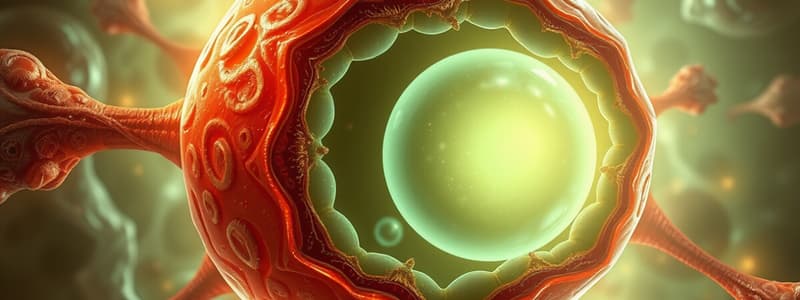Podcast
Questions and Answers
What is the air cell in an egg?
What is the air cell in an egg?
- The protective layer surrounding the shell
- The empty space between the white and shell at the large end (correct)
- The space between the yolk and the egg white
- The area where the egg's nutrients are stored
How does the air cell change in newly laid eggs?
How does the air cell change in newly laid eggs?
- It is large and prominent
- It disappears completely
- It is barely existent (correct)
- It becomes filled with liquid
Where is the air cell located in an egg?
Where is the air cell located in an egg?
- At the large end of the egg (correct)
- Surrounding the yolk
- In the middle of the egg white
- At the small end of the egg
What is primarily absent in the air cell of a newly laid egg?
What is primarily absent in the air cell of a newly laid egg?
What role does the air cell play in an egg?
What role does the air cell play in an egg?
What are the chalazae in an egg?
What are the chalazae in an egg?
What does a prominent chalaza indicate about the egg?
What does a prominent chalaza indicate about the egg?
What does the presence of chalazae signify in an egg?
What does the presence of chalazae signify in an egg?
Which of the following statements about the chalaza is true?
Which of the following statements about the chalaza is true?
What are the characteristics of chalazae?
What are the characteristics of chalazae?
Flashcards are hidden until you start studying
Study Notes
Chalaza
- Rope-like strands of egg white that anchor the yolk in the center of the egg.
- Indicates freshness; more prominent chalazae signify a fresher egg.
Air Cell
- An empty space located at the large end of the egg, forming as the egg ages.
- Barely present in newly laid eggs.
Albumen (Egg White)
- Comprises approximately 67% of the egg's liquid weight.
- Contains inner and outer layers:
- Inner thick (chalaziferous) white
- Inner thin white
- Outer thick white
- Outer thin white
- Two distinct types: thin albumen and thick albumen.
Yolk
- Yellow to yellow-orange portion, making up about 33% of the egg's liquid weight.
- Contains important proteins:
- Vitelline: primary protein in yolk.
- Phosvitin: rich in phosphorus and acts as an antioxidant.
- Livetin: high in sulfur content.
Germinal Disc
- Entry point for sperm, leading to fertilization and embryo development within the yolk.
- Identified as the channel connecting to the center of the yolk, critical for chick formation.
Membranes
- Two types of membranes protect the egg:
- Shell Membrane: includes both inner and outer membranes.
- Vitelline Membrane: encases and protects the yolk from damage.
Nutritive Value of Egg
- Eggs are classified as "super foods" due to their high nutrient content.
- Considered a complete food, high in quality proteins containing all essential amino acids.
- Rich in various vitamins, excluding vitamin C, and composed of fats, water, and minerals.
- Versatile food ingredient, suitable for cooking, baking, emulsifying, leavening, and thickening.
Introduction to Eggs
- Eggs are bird-produced foods with hard shells, offering a rich source of nutrients.
- Serve multiple culinary purposes, enhancing both standalone dishes and baked goods.
- Combining eggs with other ingredients can lead to flavorful and nutritious meals.
Studying That Suits You
Use AI to generate personalized quizzes and flashcards to suit your learning preferences.

